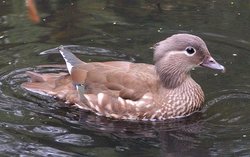Mandarin Duck
|
|
| Mandarin Duck Conservation status: Lower risk (lc) | ||||||||||||||
|---|---|---|---|---|---|---|---|---|---|---|---|---|---|---|
| Missing image Aix_galericulata,_Hannover.jpg Mandarin Ducks | ||||||||||||||
| Scientific classification | ||||||||||||||
| ||||||||||||||
| Binomial name | ||||||||||||||
| Aix galericulata Linnaeus, 1758 |
The Mandarin Duck (Aix galericulata), or just Mandarin, is a medium-sized perching duck, closely related to the North American Wood Duck. It is 41-49 cm long with a 65-75 cm wingspan.
Like its relative, the adult male is a striking and unmistakable bird. It has a red bill, large white crescent above the eye and reddish face and "whiskers". The breast is purple with two vertical white bars, and the flanks ruddy, with two orange "sails" at the back.The female is similar to female Wood Duck, with a white eye-ring and stripe running back from the eye, but is paler below, has a small white flank stripe, and a pale tip to its bill.
Mandarin Ducks are frequently featured in Oriental art and are regarded as a symbol of conjugal affection and fidelity.
The species was once widespread in eastern Asia, but it is now endangered because of large-scale exports and the destruction of its forest habitat. The populations in eastern Russia and in China are both probably well below 1,000 pairs, although Japan may have around 5,000 pairs.
Specimens frequently escape from collections, and in the 20th century a feral population numbering about 1,000 pairs was established in Great Britain. Although this is of great conservation significance, the birds are not protected in the UK since the species is not native there.
In the wild, Mandarin Ducks breed in densely wooded areas near shallow lakes, marshes or ponds. They nest in cavities in trees close to water. The Asian populations are migratory, overwintering in lowland eastern China and southern Japan.
Mandarins feed by dabbling or walking on land. They mainly eat plants and seeds, especially beechmast. They feed mainly near dawn or dusk, perching in trees or on the ground during the day.
Mandarins may form small flocks in winter, but rarely associate with other ducks.
Template:Commonsbg:Мандаринка de:Mandarinente eo:Mandarenanaso fr:Canard mandarin it:Anatra mandarina lt:Mandarininė antis nl:Mandarijneend ja:オシドリ pl:Mandarynka (ptak) fi:Mandariinisorsa zh:鸳鸯
Categories: Aix | Ducks

